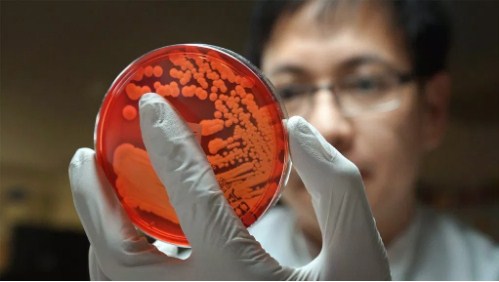Why This Strain of E. coli Is Worrying Doctors

Each year, Escherichia coli (E. coli) bacteria cause hundreds of thousands of infections in the United States.
While many infections can be treated either with rest or antibiotics, the rising rates of antibiotic-resistant E.coli infections have been a concern for health experts.When E. coli infections don’t respond to other antibiotic drugs, doctors may reach for a last-resort option known as colistin.
But in recent years, some strains of E. coli and other bacteria have developed resistance to colistin, thanks to the spread of an antibiotic-resistance gene known as mcr-1.Now for the first time a cluster of patients in the Unites States has been found to have this type of E. coli infection. A new study of liver transplant recipients published this week in Antimicrobial Agents and Chemotherapy found a cluster of four patients who had E. coli carrying mcr-1.
“Our findings represent the earliest known documented healthcare-associated cluster of mcr-1 in the United States,” the principal investigator, Dr. Anne-Catrin Uhlemann, associate professor of medicine in the division of infectious diseases at Columbia University Vagelos College of Physicians and Surgeons, said in a press release.“While mcr-1 has been described from other parts of the world, it has been very rare in the U.S.,” she said.
Only one of the patients in this study developed a clinical infection from the mcr-1-producing bacteria. The other three patients carried the bacteria without developing symptoms.E. coli has been making headlines recently for other reasons. This week the Centers for Disease Control and Prevention (CDC) is an outbreak of E. coli infections that’s affected more than 90 people across five states.
In most cases E. coli infections can be managed with rest and rehydration. Sometimes healthcare providers prescribe antibiotics to treat them.The mcr-1 gene was first reported in China in 2015, where colistin was routinely given to chicken and pigs in animal feed. The country has since banned colistin for agricultural use.
Less than six months later, the U.S. Department of Defense and Department of Agriculture identified the mcr-1 gene in bacteria cultured from a patient in . They also found the gene in intestinal samples collected from two pigs, one from South Carolina and one from Illinois.That discovery raised concerns about the potential spread of mcr-1 and colistin-resistant bacteria in healthcare and agricultural settings.
The mcr-1gene is located on a small piece of DNA known as a plasmid, which can be passed from one bacterium to another.“Mcr-1 is especially dangerous because it is capable of horizontal transfer between various types of bacteria,” Dr. Robert Glatter, a physician in the department of emergency medicine at Lenox Hill Hospital in New York City, told .
“It has now been found in not only E. coli, but [also] in Salmonella, Klebsiella, and different subtypes of Enterobacter,” he added.If colistin resistance spreads to bacteria that don’t respond to other antibiotics, it could result in untreatable infections.
“When we have no viable antibiotic options to treat active clinical infections, we risk uncontained spread of disease in the population,” Glatter said.
“It’s a daunting scenario, but one that could be on the horizon unless we either reduce inappropriate use of antibiotics or develop new ones to treat emerging and resistant infections,” he said.
Limited impact on human health
The CDC and other public health organizations have implemented to track and try to reduce the spread of mcr-1.
Although scientists continue to take the spread of this gene seriously, their worst fears haven’t yet been realized.
“If you look at the literature, there’s almost 600 papers dealing with mcr-1 since it was first reported,” Dr. Yohei Doi, an infectious disease specialist at the University of Pittsburgh School of Medicine who was involved in the initial discovery of the gene, told .
“But I’m not aware of any patient who had mcr bacteria who had to be treated with colistin and had bad consequences as a result, because they are usually sensitive to several other more commonly used antibiotics,” he said.
In the new study from Columbia University, only one of the patients with mcr-1-producing bacteria developed a symptomatic infection.
That patient was successfully treated with the antibiotic meropenem.
Reducing antibiotic resistance
Although the effects of the mcr-1 gene on public health have so far been limited, the larger issue of antibiotic resistance poses a serious problem.
“Fortunately, mcr–1 hasn’t really taken a toll on human health so far, but there are other prominent drug-resistant bugs that have negative material impacts on healthcare and patients,” Doi said.
In its list of “” for which new antibiotics are urgently needed, the World Health Organization has identified several families of bacteria resistant to carbapenem, a class of antibiotics, as critical priorities.
Vancomycin-resistant Enterococci (VRE), methicillin-resistant Staphylococcus aureus (MRSA), and many other strains of antibiotic-resistant bacteria also pose significant health threats.To help treat antibiotic-resistant infections, scientists are working to develop new antibiotics.But according to Doi, many of those efforts are carried out at small biotech firms, which face challenges surviving in a highly competitive marketplace.
“There’s a concern that most of these new antibiotics are coming from small biotechs, meaning that big pharmas, almost all of them, have left the antibiotic field, and the reason is because antibiotics don’t make money,” Doi said.
To enable the creation of new antibiotics, financial investment in research and development is needed. “Overuse and inappropriate use of antibiotics worldwide contributes to the ongoing dilemma of antibiotic resistance,” Glatter said.
To reduce the spread of antibiotic resistance, experts emphasize the importance of limiting the overuse of antibiotics in healthcare settings as well as in veterinarian and agricultural sectors.
“Programs to reduce inappropriate prescribing, along with emerging technology to differentiate bacterial versus viral infections, may help medical providers to more effectively take care of patients,” Glatter said.





